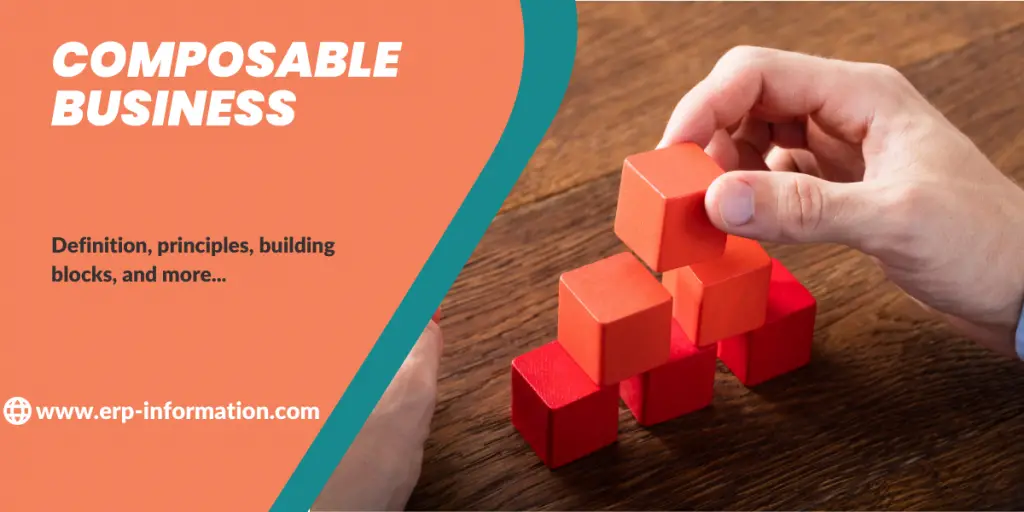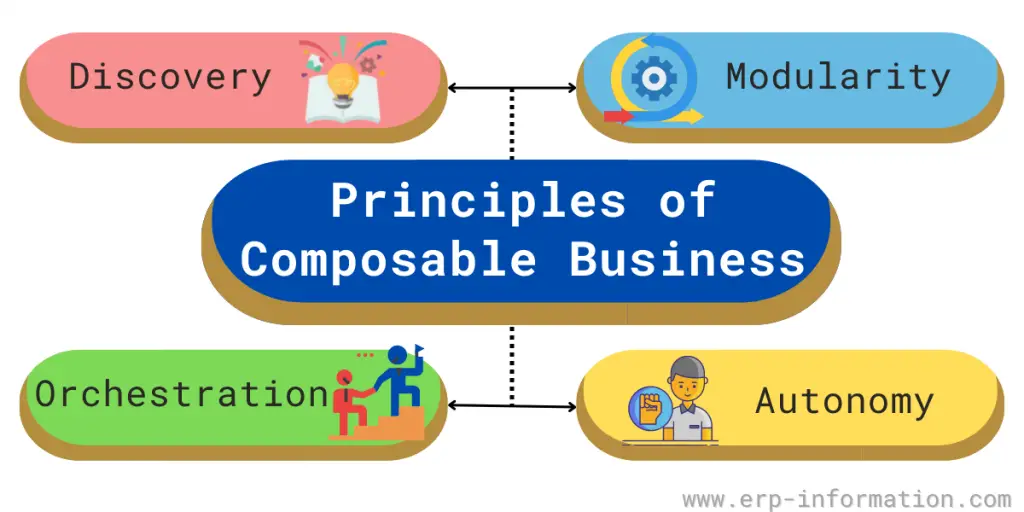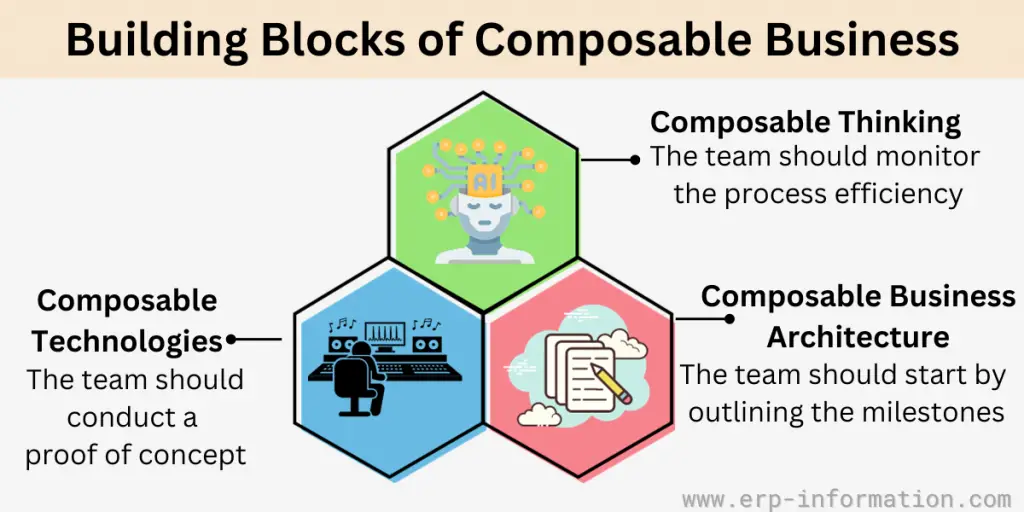We all know businesses need to be agile to keep up with the competition, but what does that mean?
Businesses are constantly being told they are required to become more “agile,” but no one seems to be able to agree on what that means.
Gartner’s new reference model for composable business shows how businesses can use modular architecture and composable applications to become more agile and responsive.
With this approach, you can quickly adapt to changes in the market by assembling the right combination of applications and services for each situation.
This article will explain the composable business, how it works, its principles, three building blocks, and its benefits.
What is a Composable Business?
It is a business that can be easily modularized and reconfigured to meet the needs of the current situation.
This can be done through composable technologies, which allow different parts of the business to be connected and worked together as needed. That will enable businesses to quickly adapt to changes in the market and respond more effectively to customer needs.
How does it work?
In a composable business, different parts of the company can be connected and worked together as needed. In addition, it allows businesses to quickly adapt to market changes by assembling the right combination of applications and services for each situation.
Using composable technologies, businesses can create independent modules that can still work together when needed. That gives enterprises the flexibility they need to respond quickly to changing conditions.
Daryl Plummer (Distinguished VP Analyst, Gartner) said, “Composable business is a natural acceleration of digital business that you live every day. It allows us to deliver the resilience and agility these interesting times demand.”
Four Principles of Composability
This works on these four principles.
More speed through discovery
When you need to move quickly, you need to be able to discover the right combination of applications and services to fit your current needs.
Greater agility through modularity
Modularity allows businesses to change and update parts of their applications without affecting the rest of the system. That makes it easier to respond to market or customer needs changes.
Better leadership through orchestration
Orchestration allows businesses to manage different parts of the business. This gives businesses greater control over their operations and helps them to respond more effectively to changes.
Resilience through autonomy
Autonomy allows businesses to continue operating even if one part of the system fails. That helps businesses to avoid disruptions and keep their operations running smoothly.
This business is a natural extension of digital business that enables businesses to be more agile and responsive to change.
By assembling the right combination of applications and services, businesses can quickly adapt to changes in the market and keep their operations running smoothly.
Building Blocks of Composable Business
Composable thinking
It means anything is composable. In other words, this is the ability to think in modular terms and see the business as a collection of independent but interconnected parts.
Composable thinking allows you to set your mindset flexibly to accept quick changes in market needs.
A combination of principles of discovery, modularity, autonomy, orchestration, and compatible thinking guide enterprises on what to compose and when to compose.
Composable architecture
It ensures that the business is flexible and resilient in structure and purpose. In addition, the structural capabilities give organizations mechanisms to architect the business.
Consider the following things while using composable business architecture.
- Engagement, technology, and capability are three dimensions of composable business architecture.
- You can consider composable business architecture in addition to your current architecture.
- It helps businesses to prepare a model to support digital acceleration.
Composable technologies
They are tools or software, including no-code and traditional BI platforms, that enable businesses to modularize their operations and connect different parts of the business.
As a result, they improve agility and flexibility to enhance the Business-to-business(B2B) customer experience.
Evolution of Composable Business
Composable business, though a fresh concept, is rapidly making waves in the technical world. At its core, it’s about dismantling an organization into its fundamental components and then reassembling them in ingenious ways to craft novel products, services, and experiences.
The origins of composable business can be traced back to the early days of software development when modular programming techniques emerged.
This approach empowered developers to break down complex software projects into more manageable, modular pieces. It streamlined development, enhanced flexibility, and simplified software maintenance and updates.
In recent years, the convergence of cloud computing and microservices has catapulted composable business to the forefront.
Cloud computing offers a scalable and dependable platform for running composable business applications, while microservices architecture dissects applications into autonomous, reusable services.
These services can be effortlessly combined and reconfigured to birth fresh applications and functionalities.
Although composable business is still in its infancy, its potential to reshape the business landscape is undeniable.
Embracing composable business principles can transform organizations into agile, innovative, and efficient entities, granting them a competitive edge in today’s dynamic market.
Here are glimpses of how composable business is making waves in the tech world:
- Netflix: Leveraging composable business principles, Netflix delivers personalized streaming experiences. Built on a microservices architecture, Netflix’s platform enables rapid feature deployment and experimentation.
- Amazon: Amazon harnesses composable business principles to fuel its e-commerce juggernaut. With a cloud-based foundation, Amazon scales operations seamlessly. Its microservices architecture facilitates the swift launch of new products and services.
- Spotify: Spotify adopts composable business principles to provide tailored music streaming. Embracing a microservices architecture, Spotify agilely rolls out features and innovations to enhance user experiences.
Growing Popularity of Composable Business
The popularity of composable business has surged due to a significant shift in leadership mentality. Change is now seen as an absolute necessity rather than an optional choice, as static structures hinder organizational resilience.
This new mindset emphasizes proactive anticipation and swift adaptation to capitalize on opportunities and navigate the evolving business landscape effectively.
Composable business provides the agility needed to seize opportunities and defend against disruptions.
Leaders embrace this approach after realizing missed prospects or experiencing unforeseen disruptions, driving them towards a more adaptable approach.
Visionary leaders leverage modularity principles to mitigate risks and create new paths, fostering innovation and competitiveness in a dynamic market.
Ultimately, the growing popularity of composable business reflects the recognition among leaders that adaptability, agility, and proactive change are vital for success in today’s ever-changing business environment.
Benefits
- Composability allows businesses to be more agile and responsive to change, which is essential in today’s fast-paced world.
- It allows businesses to become more efficient and resilient and to manage their operations better.
- Additionally, composability makes it easier for businesses to connect different parts of their operation, improving productivity and communication.
- This application can be assembled quickly and easily, allowing organizations to get new products and services to market faster.
- Composable systems are more reliable as faulty components can be replaced without affecting the entire system.
- By assembling the right combination of applications and services, businesses can optimize their operations and get the most out of their resources. This can help reduce costs and improve performance.
You are no longer limited by monolithic applications that don’t allow flexibility or customization. With composable business, you have everything you need at your fingertips.
Future
It will become increasingly important in the coming years as organizations strive to create agile and adaptive systems that can quickly respond to changing market conditions.
With this, organizations can modularise their applications and systems, making them more flexible and easier to manage.
FAQs
Why should you adopt composability?
Composability helps you to be always prepared for change so that you will not miss out on any opportunities.
It gives the combination of principles that helps to think in modular terms and see business as independent parts that are interconnected. As a result, adopting composability will help you gain a competitive edge.
What is intelligent composable business?
It is the ability to create and orchestrate business applications that allow for the reuse and composition of functions. This will enable businesses to respond faster and more agile to market changes.
What are composable business applications?
They are applications that can be assembled or decomposed into smaller parts that work together to achieve the desired business outcome. They are modular and can be composed of different services that can be reused and recombined to create new applications.
This allows businesses to quickly create new applications without starting from scratch. In addition, since they are built using reusable components, they can be rapidly configured and adapted to meet the organization’s specific needs.
What does composable technology mean?
Composable technology encompasses software or systems that are modular and can be seamlessly integrated with other technologies. This enables businesses to create customized solutions that align with their specific needs.
How would you define composable strategy?
Composable strategy is a flexible approach that involves assembling and rearranging different business capabilities to adapt swiftly to market changes, seize emerging opportunities, and optimize overall performance.
What are the challenges that come up when implementing composable business?
Embracing composable business can be a rewarding journey, but it does come with its share of challenges. First and foremost, it demands a profound shift in mindset and corporate culture, which can be a formidable task.
On top of that, you’ll need to navigate technical complexities, as a composable business relies on a sophisticated technical infrastructure.
A shortage of skilled professionals well-versed in composable business practices adds another layer of complexity. Additionally, seamlessly integrating composable business with existing systems and processes can be a substantial challenge.
What is the need for enterprises to prioritize composability in their application architecture?
In today’s dynamic technical domain, embracing composability in your application architecture isn’t just a choice; it’s become mandatory.
As the era of technology democratization unfolds, with citizen developers and fusion teams taking center stage, the focus has shifted from mere technical APIs to encapsulating essential business capabilities and API products.
Composable architecture serves as a strategic framework that fosters collaboration between business units and IT teams.
Creators play a pivotal role by packaging vital business capabilities into reusable software building blocks, which are then cataloged or placed in a centralized marketplace. Expert curators ensure that these building blocks align with the organization’s strategic objectives.
Citizen developers, represented by composers, leverage user-friendly no-code platforms to swiftly assemble composable applications. This empowers organizations to automate processes, pursue their objectives, and maintain the flexibility for minor customizations.
Prioritizing composability isn’t just about staying ahead; it’s about thriving in an era where technology knows no bounds, collaboration reigns supreme, and innovation is paramount.
What are the tips for the successful implementation of composable business?
To ensure the successful implementation of composable business, the following tips are recommended.
start small with pilot projects
obtain buy-in from leadership to secure necessary resources minimize cultural resistance, and invest in training employees on composable business principles, practices, and tools.
carefully choose appropriate tools and technologies that align with your organization’s needs.
Conclusion
Composable business is an emerging trend in the world of business and technology. It refers to a type of architecture where businesses can easily compose (or assemble) different applications and technologies to create a custom system that meets their specific needs.
Gartner has released a reference model for intelligent composable business, which can be used by companies of all sizes to deliver robust, customized applications quickly and easily.
Composability programming is still in its early stages, but it shows great promise for the future of business computing.
As more and more companies adopt composable architectures, we can expect to see even more amazing things from this innovative new approach to enterprise computing.
Reference


